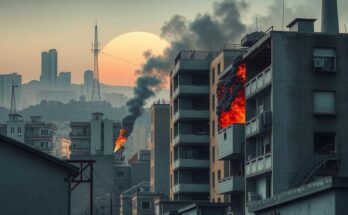Over 773 individuals have died, and 2,880 have been injured in a week of escalating violence in the eastern DRC, primarily around Goma. The M23 rebel group’s resurgence, linked to ethnic tensions and external support from Rwanda, has triggered a humanitarian crisis, displacing over 400,000 people.
In a recent surge of violence in the eastern Democratic Republic of Congo (DRC), more than 773 people have lost their lives, with an additional 2,880 sustaining injuries over the course of just one week. The epicenter of this conflict is Goma, the region’s largest city, which has been engulfed in fierce confrontations between the Congolese military and the M23 rebel group, alleged to have the support of Rwanda.
The March 23 Movement (M23), a prominent rebel faction in eastern DRC, has been responsible for some of the most severe violence in the area in recent years. Since launching a significant offensive in January 2025, M23 has taken control of strategic locations, displacing hundreds of thousands of civilians. This escalation has exacerbated existing tensions between the DRC and Rwanda, further complicating the situation.
Formed in 2012 following a military defection, M23 claims to represent the interests of the Tutsi minority in the DRC. The group derives its name from a peace agreement established on March 23, 2009, which they argue the Congolese government has failed to honor. Despite previous disarmament attempts, M23 has gained new strength and external backing, leading to its resurgence in violence.
Following their late January 2025 offensive, the M23 rebels quickly overran Goma, home to over 2 million residents, significantly altering the region’s power dynamics. Their territorial advances have raised alarms regarding potential further expansion toward Kinshasa. This offensive has resulted in a humanitarian crisis, with over 400,000 individuals displaced and medical facilities overwhelmed by casualties from the clashes.
The increasing violence is driven by several key factors, including the DRC’s accusations that Rwanda is sponsoring M23, labeling the incursion into Goma as an act of war. Notably, the rebels appear to be better equipped and trained than in the past, implying notable external assistance. Additionally, the resource-rich eastern Congo, abundant in minerals fundamental for technology, attracts various conflicting factions eager to seize control.
Moreover, ethnic tensions continue to exacerbate the conflict, tracing back to the aftermath of the 1994 Rwandan genocide. Armed groups have historically sought refuge in Congo, leading to protracted conflicts. The Tutsi-Hutu divide remains pivotal in shaping political alliances and hostilities, complicating efforts toward achieving lasting peace.
The violence in the eastern DRC represents a deep-seated conflict influenced by ethnic divisions and geopolitical interests. The M23, a rebel group primarily composed of Tutsi fighters, emerged from past military disputes, and their actions are interlinked with the region’s socio-political landscape. The DRC’s wealth in natural resources further complicates the situation, providing incentives for violence among various factions.
The ongoing conflict in the eastern DRC illustrates the complex interplay of ethnic tensions, geopolitical dynamics, and competition for valuable resources. With alarming death tolls and massive displacements, the humanitarian crisis continues to deepen. Resolving this violence requires international attention and a multifaceted approach that addresses both the underlying socio-political issues and the humanitarian needs of the affected populations.
Original Source: sofrep.com




